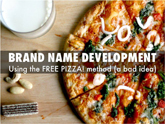Blink Versus Think – Which Branding Approach Is Better?
Sometimes a company will choose a “Blink” name for its product or service. Blink names are simple, straightforward and usually descriptive of what the product is or does. For example, you don’t have to think a lot about the name Zyliss gave their food chopper: Easy Chop, which pretty much says everything you need to know about this product. It easily chops food.
Malcolm Gladwell wrote Blink which covered in detail those decisions made in an instant. Gladwell’s premise is that in seconds a person can form an intuitive first impression that can be more valid than a carefully considered, well-thought-out, researched conclusion. Your unconscious brain takes over, which is exactly what happens with a Blink name. Your brain says “got it, now move on” in a matter of seconds.
Blink names are quite popular because companies want to save money in marketing their brands. Clients who choose a Blink name are essentially saying “I don’t have a lot of money to create meaning for a name, so I’m going to choose a name that is so simple even a caveman could get it instantly.” Blink names are like “tequila shots” as they are simple, quick and effective.
But there are a few issues with Blink names. First of all, you generally will have little differentiation by using a Blink name. As proof, here are a few competitors of the Easy Chop food chopper:
Easy Chopper
Quick Chop
Turbo Chop
Turbo Chopper
Not only is this a trademark minefield, there is the potential for substantial consumer confusion. Imagine your customer going to the store and looking for the Easy Chop product. Because the name is a generic description of the product function, he/she may get lost in the competitive confusion and end up buying the wrong product.
Another problem with Blink names is the potential for lack of registration in long-term memory. If the name of your product or service gets the “Blink treatment” it may be in and out of the brain so quickly that it just does not register, and therefore won’t be available for recall later when your customer is shopping.
“Think” names are different. A Think name causes you to pause and consider it because the meaning of the name is deeper than a Blink name. Think names engage the brain in a way that enhances memorability. They are like the “single malt scotch” that you savor and enjoy as it unfolds.
Sticking with the food chopper category, consider the name The Pampered Chef uses for its food chopper: Cutting Edge. This name is a Think name because it causes you to think about how a futuristic term (e.g., the cutting edge of technology) can apply to a mundane product such as a food chopper. By making an in-depth connection (something like: cutting edge => high tech => better design => improved performance => Cutting Edge food chopper is better), your brain has expended a sufficient amount of effort to store away the complex meaning behind the name, which enhances recall and persuasion for the product.
Think names generally require more marketing investment to register in the minds of consumers. To get Monster.com established as a premier job hunting site took a lot more investment than JobHunt.com.
But don’t go too far with Think names. If you make people work too hard to get the meaning behind the name, you will lose them and perhaps even anger them. In the food chopper category, the Starfrit Swizzz Prozzz Chopper is a great example of this. Sure, the name stands out because the use of “-zzz” is quite unusual, but “-zzz” does not have a lot of relevance for food choppers (certainly not as much as it does for sleep products, e.g., ZzzQuil® sleep aid). People will think about the name but in the end will decide it does not make sense, so they will reject it.
In my book, The Science of Branding, I discussed a study in The Journal of Consumer Research in 2005 where the researchers looked at the impact of Think names (aka ambiguous names). The researchers used crayon colors as a proxy for the trend in ambiguous brand names in all types of product categories (such as Ben & Jerry’s Chubby Hubby ice cream). The standard Crayola® Crayon color palette contains over 130 colors including ambiguously named colors such as purple heart, razzmatazz, and fuzzy wuzzy brown. The researchers developed a 2×2 grid for categorizing color names based on whether they are typical or atypical and specific or unspecific. The resulting categorization put the Crayola names into 4 categories:
Common (typical, unspecific; e.g., dark green, light yellow)
Common Descriptive (typical, specific; e.g., pine green, lemon yellow)
Unexpected Descriptive (atypical, specific; e.g., Kermit green, rainslicker yellow)
Ambiguous (atypical, unspecific; e.g., friendly green, party yellow)
The researchers then measured how the names impact consumers’ product perceptions and purchase intentions. The results suggest that color names can influence purchase intent, and that this effect is related to the typicality and specificity (or lack thereof) of the names. In general, consumers preferred ambiguous names to plain descriptive names. But completely ambiguous names without some reference (e.g., Party Yellow) can be very confusing to consumers unless there is additional information provided.
The scientists speculate that the use of ambiguous and unexpected names creates a “mind puzzle” that the customer will have to solve. When the customer makes the connection and understands why the name was chosen, he/she will have higher recall of the name and positive attributions to the product. If you use a slightly ambiguous name, the consumer might actually enjoy the “mind puzzle” and won’t have to work too hard to get your point. When consumers solve the puzzle, they will then have a sense of accomplishment because they were able to figure it out. However, if you use a truly ambiguous name (such as Party Yellow), consumers may just get frustrated, confused and move on.
While I am an advocate for Think names, I recognize that certain situations might require a Blink name. If you are using a Blink name, you need to ensure that your customer sees the branding in a way that makes it stand out from the crowd and be recognized. For example, consider the Slap Chop food chopper. The Slap Chop name by itself might be perceived as a Blink name because that is how you operate hand choppers…you slam down the chopping mechanism onto the item you are chopping. But what makes the Slap Chop product stand out is its infomercial. Once you’ve seen it you won’t forget the name.



